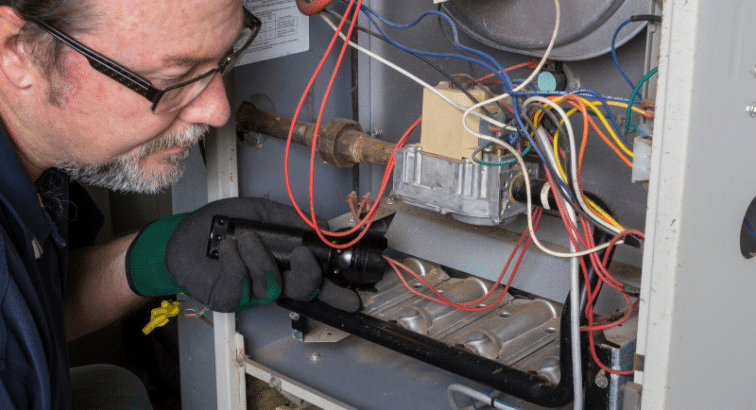When a homeowner in Austin senses a burning odor as the heater activates, it is often more than just a nuisance—it may be a warning. For residents seeking heating services in Austin TX, understanding the causes behind that smell and knowing what steps to take can make the difference between a minor maintenance call and a major repair. This article explores the typical causes of a burning smell from a heating system, highlights when it becomes serious, and offers guidance on how to address the issue safely.
Why is there a burning smell when the heater starts? (Heating services in Austin TX)
One of the most common reasons for a burning smell coming from a system is simple dust accumulation. After months of inactivity, particles settle on the heating coils, heat exchanger or blower elements. When the system is turned on, these particles burn off, producing a faint odor.
In most cases, this smell dissipates within a few minutes of operation.
However, while that benign “first‐use” smell is common, homeowners should remain alert — because if the odor persists, intensifies or changes character (for example to burning plastic or rubber), it could signify a more serious fault that requires professional attention.
When local experts discuss heating service Austin, they often emphasise that early detection of such signs can prevent broader issues like overheating, system inefficiency or even fire hazard. For example, a restricted air filter or clogged ductwork can force the blower motor or heat pump to work harder, potentially overheating components and causing that burnt smell.
What are the possible causes behind the smell?
1. Dust & debris on heat exchanger or coils
As outlined above, dust accumulation is often the culprit when it’s the first cold snap after summer. For homeowners who schedule once‐a‐year checkups, the issue is mild and short-lived.
2. Clogged filter or obstructed airflow
A dirty or clogged air filter restricts airflow, forcing the heating system—whether a gas furnace or electric heater—to overheat. The overheating parts emit that distinct “burning” smell.
In the Austin region, where air quality and dust (especially during certain seasons) are factors, regular filter changes are essential for effective furnace maintenance Austin TX.
3. Electrical component issues
When the smell shifts from “burnt dust” to more alarming scents like melting plastic or hot wiring, the problem may be electrical. Worn bearings, failing motor windings or frayed wiring insulation can overheat and pose a risk of fire.
In such cases, immediate shut-off of the system is advised, followed by professional inspection.
4. Foreign objects or materials in the ducts
Sometimes, pets, debris, or even misplaced household items find their way into the ductwork or furnace cabinet. If they come into contact with hot elements, they can smoulder and generate strange smells.
In the context of a heat pump service Austin TX, technicians often emphasise checking the air handler and return ducts for foreign material.
5. Overheating insulation or ductwork materials
In older installations or in cases where insulation has degraded or shifted, the heat generated by the system may warm up insulation or duct linings to the point of emitting a burning odor.
Such scenarios are more than inconveniences—they are red flags for safety hazards.
6. Fuel or combustion‐related irregularities (for gas furnaces)
When a natural gas or propane furnace is used, the smells may be different—sulphur (rotten-egg) or chemical hints may point to gas leaks or incomplete combustion. In Austin homes using a furnace, this is especially critical.
In such situations, evacuation and professional gas service are imperative.
How to determine if the smell is normal or serious
The question of “Is it normal for my heater to smell when first turned on?” is a frequent one. The short answer: yes, but only if the smell is faint, lasts briefly, and disappears after initial startup.
If the smell lingers, intensifies, or is accompanied by other symptoms (smoke, sparks, system shutdown, pilot light changes), then it warrants service.
Key indicators of concern include:
- Odor persists longer than 30-60 minutes after startup
- Odor resembles hot plastic, rubber, burnt insulation or wires
- Accompanied by buzzing, smoking, unusual noises or visible component heat
- Occurs repeatedly, not just at first use of season
For those seeking heating services in Austin TX, bringing these patterns to a qualified technician can lead to quicker diagnosis and repair.
Step-by-step how to fix the problem
Step 1: Shut off the system if needed
If the odor is strong, smells like burning wiring or plastic, or you see signs of overheating—turn off the system immediately at the thermostat and the breaker, and call a professional.
Step 2: Inspect the air filter and change it
A quick filter swap can often resolve the issue. Replace any clogged or dirty filter with the correct type. After replacement, run the system and observe if the smell reduces or disappears. This is fundamental to good heating maintenance Austin TX.
Step 3: Clear the area around the unit
Ensure there are no stored items, boxes, clothing or flammable materials near the furnace, heat pump, or air handler. Proper clearance reduces risk of nearby items heating up or catching smoulders.
Step 4: Check vents and ductwork for obstructions or foreign items
While deeper cleaning might require professional duct cleaning, homeowners can visually inspect accessible supply and return vents for blockages, toys, or debris. For instance, a curious pet may hide near an air handler and cause trouble.
Step 5: Listen and observe for electrical or mechanical signs
If the system runs but emits unusual sounds (buzzing, squealing, motor hum, intermittent cycling), or if the pilot flame is yellow or flickering (in a gas furnace) rather than steady blue, the system likely needs servicing.
Step 6: Schedule a professional inspection
If the smell remains, get a qualified HVAC technician to examine the heating system. During this visit, they inspect wiring, motors, blower assemblies, heat exchangers, ignition systems, and ensure safe operation. A proper heat pump service Austin TX or furnace maintenance Austin TX plan will often include these checks.
Technicians may use diagnostics to check motor amperage, wiring integrity, duct leakage, and combustion quality.
How homeowners can prevent burning smells and improve efficiency
Preventive care plays a vital role in reducing the likelihood of a burning smell and extending equipment life. Some best practices include:
- Scheduling annual maintenance before heating season—this aligns with local heating service Austin providers recommending fall tune-ups.
- Replacing filters every 1-3 months, more often if pets or dust are present.
- Keeping the area around the heating unit clear of dust and debris, and ensuring proper airflow in attics, closets or basements.
- Monitoring system performance: if heating feels weak, bills spike, or you notice strange smells, act early.
- Considering upgrades if the system is aging: old motors, outdated controls or inefficient heat pumps may be more prone to overheating and related odor issues.
By addressing these factors proactively, homeowners reduce the chance of a burning smell signaling a larger issue.
Why local climate and system type matter for Austin homes
In Austin, TX, the climate can influence heating system behavior. While winters are milder than in northern states, sudden cold snaps still require efficient performance. Many homes use air-source heat pumps for heating as well as cooling. A heat pump system that switches from cooling to heating mode may periodically produce transitional odors. In this context, a reliable provider focused on heating services in Austin TX is key.
Heat pumps require proper refrigerant charge, correct function of reversing valves, and well-maintained auxiliary electric heat strips. If auxiliary heat kicks in unexpectedly, it can overheat quickly and emit a smell.
Gas furnaces, common in some Austin homes, must ensure proper combustion air intake and exhaust venting, especially given local building codes and variable attic conditions. Poor venting or inadequate airflow can lead to overheating or combustion irregularities.
When to replace instead of repair
If during a professional inspection, the technician finds that the system has multiple failing components (motors, blower assemblies, wiring, heat exchanger cracks) or the unit is beyond 10-15 years old with low efficiency, replacement may be more cost-effective. A heater that repeatedly causes burning smells or resets its safety switches may not be sustainable. In cases of ongoing problems, investing in a newer high-efficiency furnace or modern heat pump system often reduces energy bills, improves comfort and avoids unexpected breakdowns.
Conclusion
Detecting a burning smell from the heating system should never be ignored. While some odors are benign — such as dust burning off at first use — persistent or unusual smells can indicate serious issues with electrical components, ductwork or insulation. Homeowners in Austin benefit from choosing a trusted provider of heating services in Austin TX who understands local climate, system types and maintenance needs.
By following the steps outlined above—filter changes, clearing the area, monitoring system behavior, and scheduling professional inspections—residents can ensure safe, efficient home heating throughout the cooler months. For trusted service and comprehensive care, consider Covenant as your heating and cooling partner.
Frequently Asked Questions
Q1. Is a slight burning smell when I first turn on my heater normal?
A1. Yes — in many cases when a heater hasn’t been used for months, dust settles on internal components and the first activation causes a brief burning odor. It should fade quickly (within minutes to an hour).
Q2. What kind of burning smell should I worry about?
A2. Worry if the smell persists after startup, smells like melting plastic or wires, is accompanied by smoke or sparks, or repeats every time the system runs. That often signals electrical or mechanical failure.
Q3. Can I fix the burning smell myself by changing a filter?
A3. Yes, if the cause is a dirty air filter or dust accumulation. Replacing the filter and running the system for a short time may resolve the issue. But if the smell remains or is severe, professional diagnostics are required.
Q4. How often should I schedule maintenance to avoid these smells?
A4. Most HVAC professionals recommend scheduling heating system maintenance annually, ideally in the fall before heating season. This ensures that dust, wiring, components and filters are all checked ahead of cold weather.
Q5. Is it safe to keep using the heater if I smell a burning odor?
A5. If the odor is faint, brief and resolves quickly, it’s generally safe. However, if the smell is strong, lasts long, or has other warning signs (noise, smoke, malfunctioning parts), turn off the unit and arrange professional service to avoid hazards.

